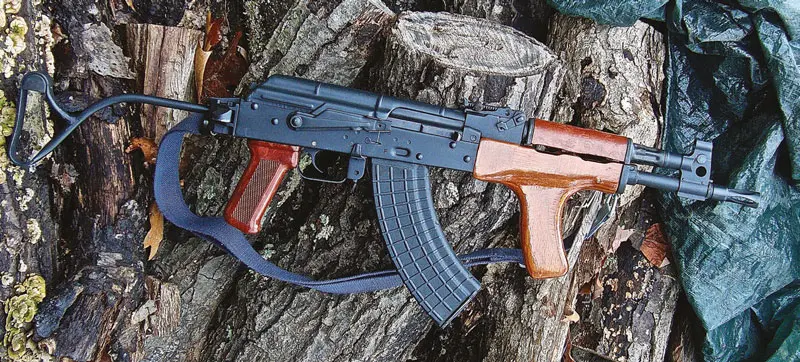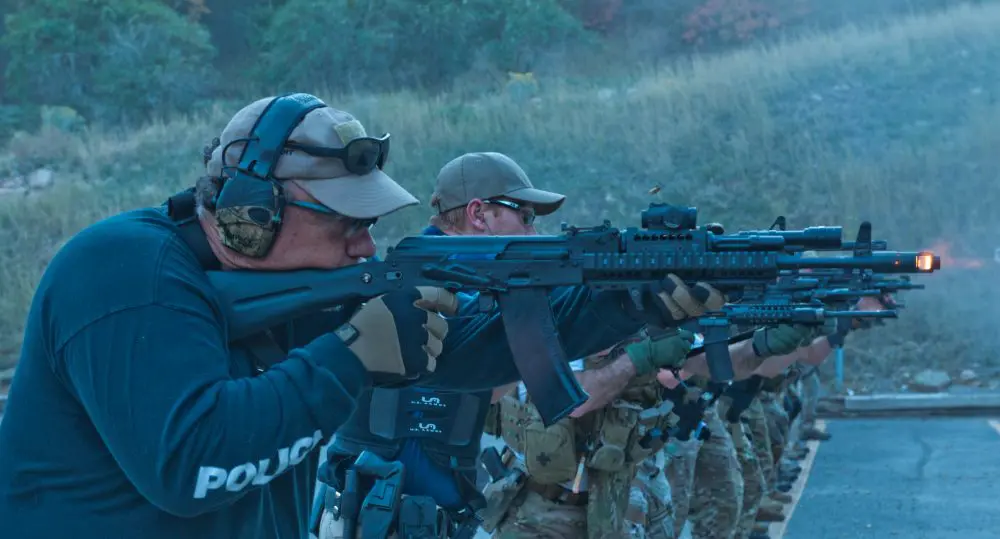I used to train individuals preparing to work in dangerous countries. I taught them various survival skills, including how to avoid trouble, but also how to be prepared to disarm an attacker and turn his weapon against him. During training, I used weapons likely to be encountered with terrorists/kidnappers in Third World countries, which generally meant Warsaw Pact weapons.
I was also involved in other training that required a wide knowledge of foreign weapons. As a result, I developed the habit of taking every available chance to shoot foreign weapons, especially those of the former Warsaw Pact.
Although I am quite familiar with the various Romanian AKs—as are many reading this due to imported parts kit rifles—one had always proved elusive. I refer to the 7.62x39mm PM Model 90 cu Teava Scurta (Short Barrel). This model was designed for tank crews and Romanian Special Forces and was chambered for the 7.62x39mm round but had a short 12-inch barrel and was just under 24 inches overall with stock folded.
Fortunately, a friend of mine who is a small-arms researcher found a parts kit for this model and had it built as a registered SBR (Short Barreled Rifle). I recently had a chance to shoot it.

I have found that SBR versions of some exotic weapons that are not normally available in the U.S. are excellent for training and familiarization purposes, because other than the full-auto capability, they handle and operate the same as the original model.
I like firing full-auto weapons, but after one learns the basic skills of leaning into the weapon when firing and controlling the trigger for short bursts, they carry over to other weapons. Bottom line—I was glad to get a chance to shoot the PM90 Short Barrel.

I remember asking a friend who did exchange training with the Romanian Special Forces awhile back if they were still using the PM90, but all he remembered seeing were G36K carbines. I know a lot of PM90 variants were supplied to the Afghans, so it is possible some of the short-barreled models are in use there.
As I understand it, some of the shortbarreled Model 90s had the front pistol grip and some did not. The side-folding wire stock is standard on short-barreled carbines. This stock is based on the East German one. I have seen two methods of release used on these stocks—a push button and a lever. The version I shot for this article used the push button.
As with the earlier PM65, the various versions of the PM90 are similar to the AKM in operation. The selector has three positions: up, which is safe and blocks the bolt handle; middle, which is single shot; and down, which is full auto. Jane’s lists the cyclic rate of the PM90 Short Barrel at 600 RPM, the same as the full-sized rifle. I would expect that it might be a bit faster. The PM90 SB does have a flash suppressor (but no bayonet lug), which seems to work fairly well on fast semi-auto fire.
For full-auto usage, I would prefer the version with the front pistol grip, though as with any of the Romanian rifles with this feature, it is more difficult to insert a 30-round magazine.

The front hooded post is typical of AKM-based rifles, but is moved to the rear of the gas block to allow mounting of the flash suppressor. Windage and elevation adjustments are still made using the typical AK sight tool. A shortened gas piston is also used. The rear sight is somewhat typical, though only offering adjustment to 500 meters. With a short-barreled carbine, that is fairly optimistic….
The only one of the Romanian AK variants I have fired that was select-fire was the Model 63 with fixed stock and foregrip. That was quite a few years ago, when visiting with a European military unit that had one in their firearms collection. I did find the foregrip helped keep muzzle rise down somewhat.
I also found with the foregrip on that weapon and the Model 90 SBR I fired that the foregrip offers two options for cocking the weapon. The support hand can be used to come over the top of the receiver and pull back the bolt handle with the edge of the palm, or the support hand can grasp the foregrip and press the rifle back against the shoulder while the shooting hand is used to cock the bolt handle.
There is a third method I was taught by some ex-Spetsnaz in Russia. They reach under the receiver with the support hand to cock the bolt handle with the palm. I didn’t try this, but I think the foregrip would get in the way.
With Romanian AK versions with the foregrip, I usually use the method of gripping the foregrip and cocking the rifle with my shooting hand, as it keeps the rifle more closely aligned with the target.
Other than only being able to fire on semi-auto, I got a good feel for what shooting the Model 90 Short Barrel would be like. There was a wooded area right next to the range, so I tried moving through some of the trees and undergrowth, and found that the short barrel was less likely to snag, but the foregrip made it advisable to keep the carbine close to the body to avoid it snagging, especially if the support hand were removed from the forward grip.
The sights were typical AK in that they were usable but not great. My friend who owns the weapon had taken the time to zero the sights, so I was hitting consistently when I was shooting at plates at 50 yards. Trigger pull was about like other semi-auto AK variants.
As with some other weapons that were never legally imported into the USA or only imported in very small numbers as military or law enforcement reference items, about the only way to own a PM Model 90 Short Barrel is by finding a parts kit, getting a U.S.-made or imported semi-auto receiver, registering it as an SBR, and having it built using the proper number of U.S.-made compliance parts. As I understand it, even this will be difficult, as only a few of the parts kits were ever imported.
My conclusion is that, though I am a fan of the Russian AKSU, a compact 7.62x39mm carbine is more desirable. The primary disadvantages of the PM90 SB are its rather uncomfortable stock, which I fear would climb on the shoulder during longer bursts, and the problems with quickly inserting or removing a 30-round magazine with the foregrip.
Still, had I not had access to the PM90 SB, I would not have been able to draw these conclusions for myself.





